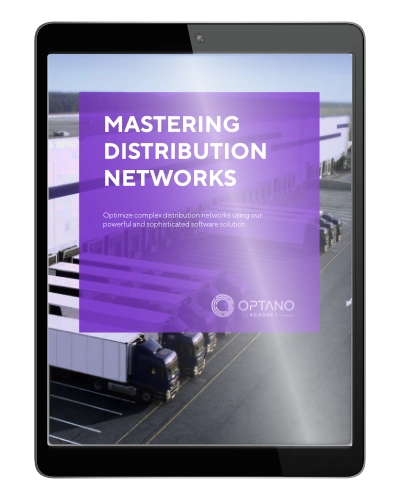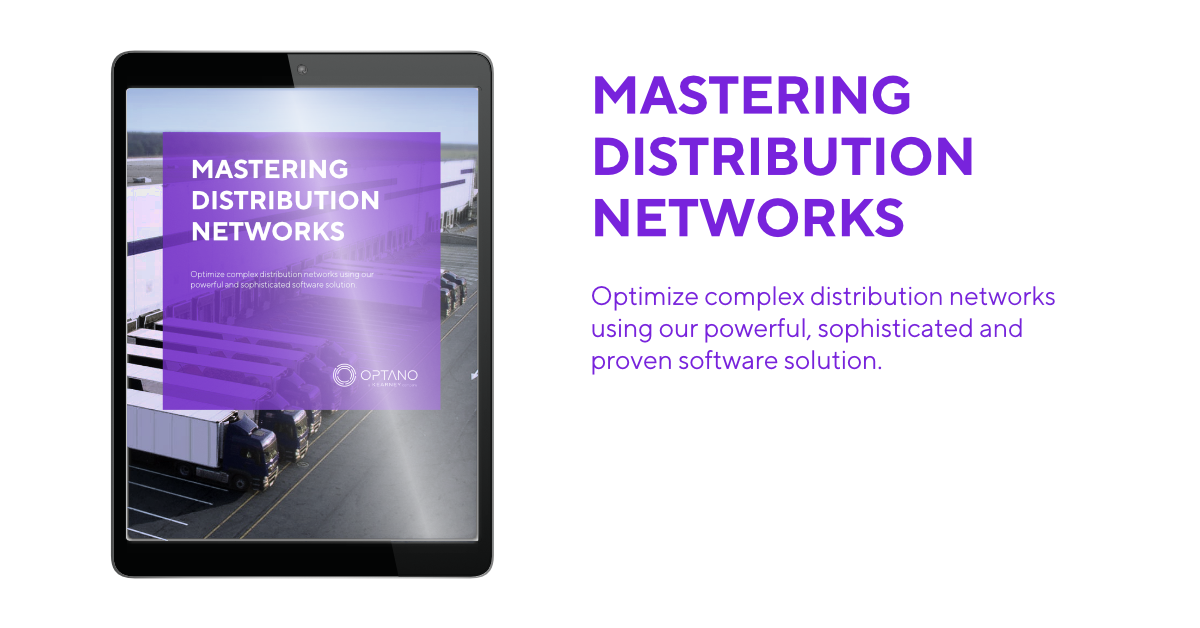Optimization potential in distribution networks
From the foothills of the Harz mountains into the world
Halberstadt – for those who have already heard of it, they will probably know it merely as a town near the Harz mountains in Germany. However, its status is set to change. As of 2025, Halberstadt will be the hub for the global supply of spare parts for Mercedes-Benz trucks. Daimler Truck is building a logistics center here, which will be its largest to date.
20 regional logistic centers worldwide are to be supplied from this small town in the German state of Saxony Anhalt. These are various European countries, Turkey, the United Arab Emirates, Brazil or China. According to the corporation, up to 300,000 parts, from the smallest screw to a finished truck cabin, will be dispatched to 3,000 vehicle dealers in more than 170 countries.
The figures in this example of after-sales logistics prove just how complex one logistics center in a distribution network can be. In this article, you will learn more about how intelligent planning can contribute towards creating a competitive distribution network for your products.
Complex distribution networks have great potential
A distribution network is determined by the allocation of its production sites, storage and trans-shipment facilities as well as transportation options and customer demand. These interrelationships must always be taken into account in network optimization. Although a variety of interactions and restrictions result in a high level of complexity, they also offer a great deal of optimization potential.
Who should be supplied?
On the one hand, customers expect a high availability of goods and fast delivery. At the same time, the margin pressure on companies is enormous, particularly in highly competitive markets. Costs for storage and transport should be as low as possible. Therefore, finding the best trade-off between the service level and logistics costs is key. In a distribution network it is crucial to know which customers should be supplied from which warehouse and via which route?
Strategic, tactical and operational planning
Distribution network planning involves many different tasks. These are divided into strategic, tactical and operational fields. In this article we will focus on the challenges in the tactical planning of a distribution network.
Nevertheless, strategic planning, such as siting when building or purchasing, also offers huge potential. Deploying methods like route planning can also optimize your distribution from an operational viewpoint. (Read more about this in our blog “Optimized deployment and route planning”)
As already mentioned, the choice of location for depots and distribution centers is largely a strategic planning operation that should contribute to a company’s sustainable added value. However, there are many tactical aspects that need to be taken into account and these tend to change constantly. In addition to direct monetary aspects such as subsidies, tax benefits and other funds, many other (location) factors have a major influence on both the costs and the degree of delivery readiness. We will take a look at exactly how in the following:
Storage capacity: So many restrictions…
Optimal storage capacity depends on several factors. Demand forecasts can help to identify which products are required in which quantities and in which sales territories. Existing transshipment depots are also subject to further restrictions regarding their capacity, for example loading options. The number of loading bays, e.g. for trucks, is not the only significant factor. The degree of automation in a warehouse is equally crucial for handling, storing and retrieving goods, as the duration of a pick has an impact on the throughput of the entire warehouse and therefore on its efficiency. It should be noted that not all warehouses in the distribution network have the same level of capacity.
Let's talk about the direct costs
It is easy to accurately specify the direct costs of a warehouse or transshipment depot. These are incurred for the space through rent, purchase or construction and the operation of the logistics or distribution center. Personnel costs vary depending on the location. They also depend on the degree of automation in the depot. For example, a high degree of automation results in lower personnel costs, but higher investment costs must be taken into account.
When considering the overall costs, the service level must also always be taken into account. The question is: what size should the warehouse be and what automation technology should it have to achieve the defined delivery readiness level without running up excessive costs.
The devil is often in the detail – and also in transport
As with the points already mentioned, a high level of service also competes with transportation costs. In addition, the complex interactions between transport and warehouse flows should be detailed in the planning, because without explicit consideration, you only get “one side of the story”. Or to put it another way: Saved storage costs must not be “swallowed up” by higher transportation costs. And conversely, any subsequent costs in the warehouse should be taken into account when optimizing transport costs.
With these interactions in mind, the most cost-effective mode of transportation should always be selected. The degree of complexity can increase here considerably: whether by ship, plane, rail or truck – not only the choice of transport mode, but also the distance of the transports and their number are factors that must be taken into account during planning. And ultimately, they not only have an impact on costs, but also on the environment in the form of their carbon footprint.
The CO2 balance– an important issue
The pressure on companies to manage their own CO2 footprint is growing by the day. Both the public and governments in various countries are calling for CO2-reduced action. With regard to transport flows, it would be very easy to take measures to achieve this: Both the number of jounreys and the number of transport kilometers can be reduced. Journeys are only carried out when the load is full. However, reducing the frequency of deliveries as a result of long waiting times is at the expense of delivery times. This means that the reduction in transport journeys competes, in turn, with the service level, for example when customers want next-day delivery, not two days later.
Establishing an emission-free fleet in the company is initially associated with high investments. These are reflected in the cost breakdown and thus (initially) reduce the efficiency of the distribution network.
And it gets even more complex
Planning warehouse and transportation flows can be far more complex than described. It would take too long to list all of the challenges in a distribution network here so let us briefly mention that planning in retail can often be even more complex. If business models such as omnichannel are used, the availability of goods in stores and delivery times, for example for in-store collection, must be guaranteed in order to fully meet customer requirements.
One point should also be mentioned here: the distribution of products at national level can already be very complicated, but as soon as this is extended globally, the level of complexity increases considerably. This is because it is not only aspects such as wage differences and currency fluctuations that need to be taken into account. Recent geopolitical events in particular have highlighted just how fragile international networks actually are.

The road to optimization
The interactions and restrictions mentioned in the previous section lead to a high level of complexity in distribution networks. However, this should not prevent you from improving your network planning, as the greater the complexity, the greater the potential for optimization. Find out below how you can exploit this potential.
Yet we must be honest: it won’t work without your commitment. Processes in the distribution network must be understood and, if necessary, redefined. Interactions and restrictions must be identified and their impact taken into account. All of the stakeholders should be involved at an early stage to deal with the tasks that will arise.
In our projects, we continuously find that many new insights can already be gained during the preparatory work. These are extremely valuable for companies and can be used as a basis for initial quick wins. As you can see: Your commitment pays off!
Formulating the objective - service level vs. costs
Goals must be defined in order to achieve them. To plan an optimal distribution network, you need to consider service levels as well as delivery readiness. In addition, you should formulate an upper cost limit that allows you to remain marketable and marginable as a supplier or subcontractor.
You will often find that defined goals compete with one another. In order to prioritize them, it is advisable to define the goals using KPIs (Key Performance Indicators) and weigh them up against each other. The more objectives are formulated and the more they contradict each other, the more complex your planning becomes.
Data processing and analysis for transparency
One of the first steps is to identify relevant data and to prepare and make it available for further action. To do this, standardized data structures must be created if they do not exist already. This may even mean that analogue data has to be digitized.
The next step is to turn the data into information. Data analysis is essential here. If this is not possible with your current IT infrastructure, it is advisable to introduce an analysis layer. This can be an external tool that can be connected to all relevant data sources via an interface. The data preparation and analysis help to evaluate the degree of target achievement based on the previously defined KPIs. This often reveals cost structures and interactions that had not been taken into consideration beforehand.
In particular, the graphical visualization of the distribution network as a network of production sites, depots, transportation options and customer demand can help you make better decisions. An overview of all the relevant master data, relations, interactions, KPIs, demand forecasts, transport modes and costs can help to create transparency – and serve as a basis for optimized planning.
Optimizing the distribution network
The key to increasing efficiency is to distribute the goods in the network in order to achieve the defined service level and, at the same time, ensure that the upper cost limit is not exceeded. Both the storage costs at the individual locations and the transportation costs must be taken into account here. This includes not only optimizing the distribution structure, i.e. the number, location and capacity of the transshipment points, but also planning general delivery strategies to reduce the number of journeys and kilometers driven.
As we mentioned at the beginning, this article focuses on tactical planning. However, we would also like to point out a classic strategic consideration: renting, buying or even building new warehouses at neuralgic locations can also be a solution. (Find out more by reading our article “Mathematical optimization for facility location planning”).
More interesting articles
Discover the potential – with OPTANO
Isn't manual planning enough?
Manual planning with the likes of Excel is possible to a certain degree of complexity but in this article we have explained how fast the challenges in distribution network planning can increase and so manual planning quickly meets its limits. This is where software, such as OPTANO with its algorithmically optimized decision support, comes into play.
Our experience to date has shown that savings potential through intelligent decision-making support can increase with the complexity of the network. Especially when it comes to identifying and leveraging the hidden potential in planning processes, a software like OPTANO is unbeatable.
OPTANO – define your goals with our team
OPTANO projects start off with a workshop in which all stakeholders come together. Our project leaders have a wealth of experience in all kinds of business sectors and can help you to understand your network structures and identify the relevant data. If this is not available in a processable form, no problem! We can prepare it. In this way, we create the basis for the targeted optimization of your network.
Determining the right objective is the next step. In practice, objectives are often unclear or vaguely formulated. When optimizing distribution networks, for example, the question arises: Should storage and transport costs be minimized or should the service level be maximized? Our clients also benefit from the OPTANO team’s experience here. We help you to define measurable targets and prioritize them.
OPTANO turns data into information
As optimization software, OPTANO analyzes and maps data as a model. In many cases we first create a quick prototype in the form of a MVP (minimum viable product). This gives you an early impression of what the optimization will look like. After that we run a validation to ensure that the results have been presented correctly. We test the model extensively to guarantee that the optimization runs error-free.
Complex networks with their locations and transport connections can easily be mapped with all the relevant KPIs, relations and master data. Interactions and inefficiencies can be identified better and far more quickly.
By using mathematical optimization methods, a large number of different goals can be taken into account and the trade-off between conflicting goals becomes visible. Our powerful algorithms always calculate the best possible result from millions and millions of options. This allows you to consciously make the right decision.
With the help of Prescriptive Analytics, OPTANO not only formulates targeted options for action, but also enables the simulation of decisions and interventions in the network thanks to what-if scenarios. For example, these allow you to examine how changing cost structures and demand at individual locations would affect the overall system. OPTANO ensures the necessary transparency and optimal planning throughout the entire network at all times.
Who should be supplied? The algorithm has the answer
As described in the previous section, our optimization model ultimately assumes the planning of your distribution network. Conflicting objectives between service levels and cost minimization are systematically identified and optimized with a view to increasing the efficiency of the network. Demand forecasts can be used to determine storage and delivery capacities. What-if scenarios not only enable the optimization of the location and number of sites or the decision between make or buy. So-called “greenfield” scenarios can also be examined for feasibility and potential.
If transport costs and CO2 emissions are to be reduced, bundling deliveries can minimize the number and distance of transports. Perhaps interim storage is the solution to maintain the service level? Or deliveries from different warehouses? Various approaches can be simulated with the help of what-if scenarios. The optimization algorithm ensures that you always make the best decision.
In contrast to manual planning, the model is so flexible that any number of boundary conditions can be taken into account. There are virtually no limits to the planning possibilities. No matter how the parameters change, you can always rely on OPTANO to make the best possible – and scientifically sound – decision with regard to your goals.
Don’t be afraid to tackle optimization, no matter how complex your distribution network may be. With the help of intelligent, mathematically supported planning, optimization potential can be identified and used to your (competitive) advantage.
You can be confident that with our help and our optimization software you can also increase efficiency and sustainability in your company.
Whether or not Halberstadt, Munich, Paris or Tokyo are the right locations to increase the efficiency of your distribution network depends on its framework conditions. One thing is certain, however: you will make the optimal decision with the help of mathematical optimization.
Have you got our Factsheet on this topic?

Distribution networks are complex and present retailers and producers with a variety of challenges. They have to guarantee the availability of goods on omni-channel sales channels, deliver in the fastest possible time and work at the lowest possible cost. In this factsheet, we show the possibilities offered by the OPTANO solution for distribution networks.
To obtain our factsheet, all you need to do is enter your contact details in the space below. A pop-up window will then open to download the whitepaper. Please note that by providing us with your email address, you agree that we may contact you on this topic. You may revoke this agreement at any time by contacting [email protected].







